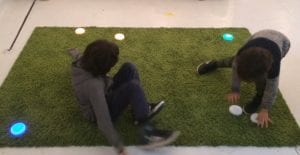Many teachers are already aware of how useful Clicker 7 is in the classroom. Clicker 7 is a talking word processor with predictive text, grids of words to support the early writer with spelling and offers a built-in planning tool to help learners prepare for writing. (see previous blog post)
Many schools have had earlier versions over the years: Clicker 3, 4, 5, or 6. It can be loaded onto Windows PCs and Macs.
For iPads and Chromebooks
This marvellous piece of software has been split into smaller pieces to make it work well on iPads and Chromebooks without taking up so much storage and without costing so much. The apps cost from £30-£32 each.
There are four apps for iPads and 3 apps for Chromebooks.
Clicker Sentences
Clicker Sentences is ideal for emergent writers, English language learners and for older children struggling to acquire basic literacy skills. It supports children building their first sentences using words from a grid with options for differentiated writing support. It offers model sentences, illustrated writing as well as speak feedback.
Clicker Connect
 Clicker Connect is for developing or struggling writers and is good for children moving on from using Clicker Sentences. It scaffolds independent writing by offering words and phrases to support children as they build coherent text. It offers colour-coded cells containing words & pictures and speech feedback.
Clicker Connect is for developing or struggling writers and is good for children moving on from using Clicker Sentences. It scaffolds independent writing by offering words and phrases to support children as they build coherent text. It offers colour-coded cells containing words & pictures and speech feedback.
Clicker Docs
Clicker Docs is for primary pupils of all abilities especially pupils with dyslexia and struggling spellers. Clicker Docs encourages independent writing with the support of word prediction and word banks and has a talking spell checker and speech feedback.
Clicker Books
 Clicker Books is for primary pupils of all abilities, pupils with dyslexia and struggling writers. Clicker Books lets pupils create their own talking books, including pictures and speech input, using a range of differentiated support. Teachers can create reading books for pupils. It has word banks, word prediction, a talking spell checker and a sound recorder.
Clicker Books is for primary pupils of all abilities, pupils with dyslexia and struggling writers. Clicker Books lets pupils create their own talking books, including pictures and speech input, using a range of differentiated support. Teachers can create reading books for pupils. It has word banks, word prediction, a talking spell checker and a sound recorder.
















